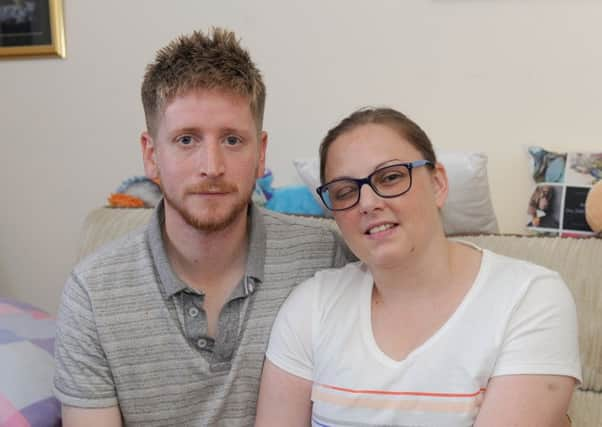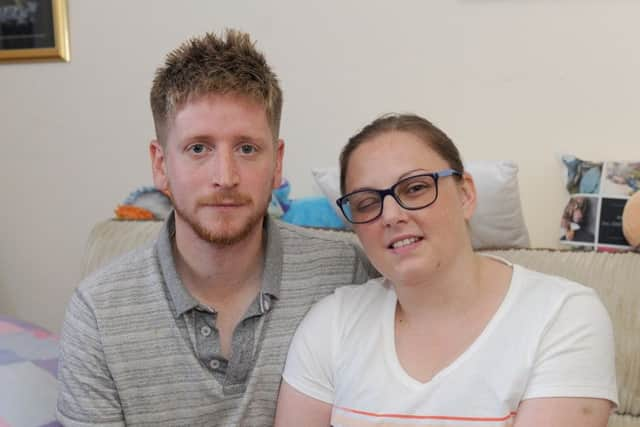WATCH: '˜I just try to enjoy the good days'


The 34-year-old from Milton has been diagnosed with Vascular EDS - a genetic condition which means her blood vessels and organs could rupture at any time.
It affects her life in so many ways. She had to give up work and has decided not to have children to prevent it being passed on.
Advertisement
Hide AdAdvertisement
Hide AdSusie has decided to tell her story to raise awareness of the condition.


‘Ever since I was born I had multiple health issues,’ she says.
‘I had illnesses, I was covered in bruises. At the age of four, social services were requested to check on me because of the amount of bruises I had.
‘My GP said that there was nothing going on. But if I was ill, it would take me longer to heal. Scars would form. I would constantly sprain things. Just walking down the road I would get a sprained ankle. I was probably the clumsiest kid about.’
Advertisement
Hide AdAdvertisement
Hide AdBut it wasn’t until 2011, when Susie was 28, that she realised something wasn’t right.


‘We were walking to the shops and my leg started to feel funny. I just thought maybe I was walking strangely.
‘But then I was holding myself up in the shop and I said to my partner that my leg really hurt. It stopped and started again. I just left it and went to work.’
But the pain returned and Susie decided to get it checked out. Tests showed that there was a lack of blood flow to her right leg and she was at risk of losing it.
Advertisement
Hide AdAdvertisement
Hide AdShe had several tests and had to wait three months for the results. In October, 2011, she was officially diagnosed with Vascular Ehlers-Danlos Syndrome.
It is caused by an alteration in the genes that make a person’s collagen proteins weak. These proteins are needed to strengthen and support various body tissues in tendons, skin, bone, blood vessels and the spine.
This means that a person with EDS can dislocate and tear ligaments just by everyday walking.
Vascular EDS accounts for less than five per cent of all EDS cases and is the most severe form of EDS.
Advertisement
Hide AdAdvertisement
Hide Ad‘It was just sheer panic that there was something wrong that was quite serious,’ she says, recalling the moment of her diagnosis.
‘But as the blood tests took three months, I just knew that I had it as I had done a lot of research into it.’
Susie underwent an eight-hour operation after the main vain that drains the brain attempted to push her eye out of its socket. But despite the surgery she continues to have problems and now can’t see out of one eye.
‘It’s just made everyday tasks much harder,’ she adds.
‘I’ll feel sick and vomit. If I do too much then it’s days spent in bed with painkillers.’
Advertisement
Hide AdAdvertisement
Hide AdSusie has had to rely heavily on her husband Rob, who has been a real rock.
She says: ‘We have been together since 2001. There have been a few challenges.
‘You can’t plan to go on holiday and travel due to trying to plan how I am going to be feeling or how many medical things we need to take with us.
‘I think I have just tried to deal with things when they happen. On the good days, you try and enjoy them.
Advertisement
Hide AdAdvertisement
Hide Ad‘I think sometimes I worry people when I’m laughing and joking when things can be so serious – but I don’t really have a choice.’
Susie relies on many drugs including painkillers and anti-sickness tablets.
‘My digestive system doesn’t work that well, so there’s medication to help with that too,’ she adds.
‘That plays a massive part in what we eat and where we eat.
‘There is an average life span of late 40s or early 50s. Any surgery is the last option as I am at risk of an aortic aneurism.’
Advertisement
Hide AdAdvertisement
Hide AdIf Susie and Rob were to have children, there’s a 50 per cent chance that Vascular EDS would be passed on.’
So Susie and husband Rob made a decision not to start a family.
Susie says: ‘The risk to the child and myself meant that Rob would have to look after the child and the child would have to watch me go through what they might go through.’
Now, Susie hopes she can do her bit to raise awareness.
‘I think there’s a lot of confusion,’ she says.
‘There’s a lack of knowledge about how serious Vascular EDS is. I want to highlight how it affects people.’
Rob, 33, adds: ‘I just try and be as supportive as I can.
Advertisement
Hide AdAdvertisement
Hide Ad‘We just have to slow down a bit. We can’t plan too much in advance. We just try and make the most of the good days.’
WHAT IS VASCULAR EDS?
Vascular EDS is a serious life-limiting genetic condition which affects between one person in every 50,000 and one person in 200,000 in the UK.
Mr Paul Gibbs, a vascular surgeon at Portsmouth Hospitals, says: ‘Living with Vascular EDS results in a number of problems.
‘Day to day it makes a person bruise incredibly easily as their blood vessels are more fragile.
Advertisement
Hide AdAdvertisement
Hide Ad‘If Susie was to bump into a table for example, because her skin is so thin – about one-third of the normal thickness - her bruises would look very spectacular.
‘Her wounds then heal abnormally, with most resulting in deeply pigmented scars. ‘
Mr Gibbs adds: ‘The greatest issue for those with Vascular EDS, though, is that you never know when the next true catastrophe is going to happen and whether it will result in your death.
‘Susie says having Vascular EDS is a life sentence which will ultimately take her life.
‘For that reason she wants to spread the word about the symptoms because, if the diagnosis is known, management of the condition is more successful and survival is higher.’